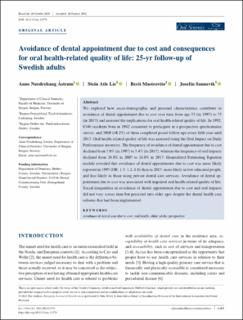Avoidance of dental appointment due to cost and consequences for oral health-related quality of life: 25-yr follow-up of Swedish adults
Journal article, Peer reviewed
Published version

View/
Date
2021Metadata
Show full item recordCollections
- Department of Clinical Dentistry [472]
- Registrations from Cristin [10186]
Abstract
We explored how socio-demographic and personal characteristics contribute to avoidance of dental appointment due to cost over time from age 55 (in 1997) to 75 (in 2017) and assessed the implications for oral health-related quality of life. In 1992, 6346 residents born in 1942 consented to participate in a prospective questionnaire survey, and 3060 (48.2%) of them completed postal follow-ups every fifth year until 2017. Oral health-related quality of life was assessed using the Oral Impact on Daily Performance inventory. The frequency of avoidance of dental appointment due to cost declined from 7.0% (in 1997) to 5.4% (in 2017), whereas the frequency of oral impacts declined from 26.0% in 2007 to 24.0% in 2017. Generalized Estimating Equation models revealed that avoidance of dental appointments due to cost was more likely reported in 1997 (OR: 1.5: 1.2–1.8) than in 2017, more likely in low educated people, and less likely in those using private dental care services. Avoidance of dental appointment due to cost was associated with impaired oral health-related quality of life. Social inequalities in avoidance of dental appointment due to cost and oral impacts did not vary across time but persisted into older ages despite the dental health care reforms that had been implemented.
